
| Part of a series on |
| American cuisine |
|---|
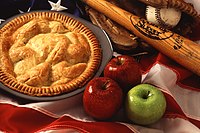 |
Regional cuisines
|
| History |
| Ingredients and foods |
| Styles |
| Ethnic and cultural |
| Holidays and festivals |
A food truck is a large motorized vehicle (such as a van or multi-stop truck) or trailer equipped to store, transport, cook, prepare, serve and/or sell food.
Some food trucks, such as ice cream trucks, sell frozen or prepackaged food, but many have on-board kitchens and prepare food from scratch, or they reheat food that was previously prepared in a brick and mortar commercial kitchen. Sandwiches, hamburgers, hot dogs, chicken, tacos, pizza, french fries and other typical fast food and finger food staples are common food truck fare, though since the pop-up restaurant phenomenon of the 2010s, food trucks specializing in a wide variety of gourmet, specialty, global, regional, and fusion cuisines have seen growing popularity. Food trucks often also sell or fully specialize in beverages such as soft drink, juice, coffee, tea, and water, as well as treats such as ice cream, pastries, and fried dough.
Historical predecessors of food trucks were horse-drawn chuckwagons and lunch wagons of the 19th century. By the early-to-mid-20th century, trucks and vans were being used both as mobile canteens in the military and as "roach coaches" that traveled to worksites and primarily catered to blue-collar workers. Into the 21st century, economic and cultural shifts surrounding the foodservice industry led to a considerable rise in popularity among customers and food truck operation as a career. Though food trucks primarily developed in the United States, United Kingdom, and France, they have become increasingly popular and more available in other parts of Europe and the Americas, as well as Asia and Oceania.
Food trucks, along with food booths and food carts, are major components of the street food industry that serves an estimated 2.5 billion people daily.
History
| The examples and perspective in this section deal primarily with the United States and do not represent a worldwide view of the subject. You may improve this section, discuss the issue on the talk page, or create a new section, as appropriate. (August 2021) (Learn how and when to remove this message) |
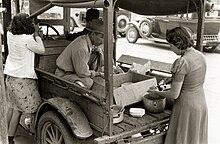
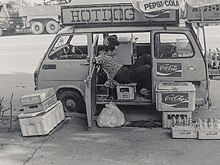
United States
In the United States, the Texas chuckwagon is a precursor to the American food truck. In the later 19th century, herding cattle from the Southwest to markets in the North and East kept cowhands on the trail for months at a time. In 1866, the "father of the Texas Panhandle", cattle rancher Charles Goodnight, fitted a sturdy old United States Army wagon with interior shelving and drawers, and stocked it with kitchenware, food, and medical supplies. Food consisted of dried beans, coffee, cornmeal, greasy cloth-wrapped bacon, salt pork, dried or salted beef, and other easy-to-preserve foodstuffs. The wagon was also stocked with a water barrel and a sling to kindle wood to heat and cook food.
Another early relative of the modern food truck is the "lunch wagon", horse-drawn street cars whose night version was known as the "night owl", as conceived by food vendor Walter Scott in 1872 as a "kitchen on wheels". Scott cut windows in a small covered wagon, parked it in front of a newspaper office in Providence, Rhode Island, and sold sandwiches, pies, and coffee to pressmen and journalists. By the 1880s, former lunch counter worker Thomas H. Buckley was manufacturing lunch wagons in Worcester, Massachusetts. He introduced various models, like the Owl and the White House Cafe, with features that included sinks, refrigerators, cooking stoves, colored windows, and other ornamentation.
In 1936 the Food Code spread its regulatory umbrella to include food trucks as a result of their introduction to society.
Later versions of the food truck were mobile canteens, which were created in the late 1950s. These mobile canteens were authorized by the U.S. Army and operated on stateside Army bases.
Mobile food trucks, nicknamed "roach coaches" or "gut trucks", have been around for years, serving construction sites, factories, and other blue-collar locations. In big cities, the food truck traditionally provided a means for the on-the-go person to grab a quick bite at a low cost. Food trucks are still sought out for nostalgia from this era.
During the 2010s the economic changes caused by the Great Recession, technological factors, and street food being "hip" or "chic" have combined to increase the number of food trucks in the United States. The construction business was drying up, leading to a surplus of food trucks, and chefs from high-end restaurants were being laid off. For experienced cooks suddenly without work, the food truck seemed to be a clear choice and a smaller financial investment than a brick-and-mortar restaurant. Once more commonplace in American coastal big cities like New York City and Los Angeles, gourmet food trucks are now to be found as well in suburbs and small towns. Food trucks are also hired for special events, like weddings, movie shoots, and corporate gatherings, and also to carry advertising promoting companies and brands.
Gourmet trucks

In 2011, USA Today noted that food trucks selling pricier food were gaining popularity across the United States, contrary to a common perception that food trucks are typically run-down and found at construction sites. In 2009, New York magazine noted that the food truck had "largely transcended its roach-coach classification and is now a respectable venue for aspiring chefs to launch careers." These gourmet trucks' menus run the gamut of ethnic and fusion cuisine. Often focusing on limited but creative dishes at reasonable prices, they offer customers a chance to experience food they otherwise may not. Finding a niche seems to be a path to success for most trucks. While one truck may specialize in outlandish burgers, another may serve only lobster rolls.
Gourmet food trucks can also offer a unique dining experience. With the rise of millennial diners, experiential dining has become more mainstream, driving restaurant and food truck owners to create a unique experience for their customers. As food trucks are mobile, this provides an advantage to gourmet trucks to take their experience anywhere they may please.
Food truck rallies

Food truck rallies and food truck parks are also growing in popularity in the United States, wherein multiple food trucks gather in one location, usually in cooperation with each other, with the goal of attracting business through the variety offered. On August 31, 2013, Tampa, Florida hosted the world's largest food truck rally, with 99 trucks attending. The Tampa Rally broke its own record by bringing together 121 food trucks in 2014. The Chicago Food Truck Festival hosts over 40 trucks each year with 60,000 guests participating over two days in Chicago. Food truck parks, offering permanent locations, are found in urban and suburban areas across the US.
Business and economics

Food trucks are subject to the same range of concerns as other foodservice businesses. There are a variety of permits to obtain, and a health code to observe. Equipment, labor and fuel costs are a significant part of the overhead.
Legal definitions and requirements for food trucks vary widely by country and locality. For example, in Toronto, some of the requirements include business and liability insurance, a Commercial Vehicle Operator's Registration for the truck, permits for each municipality being operated in (downtown, various suburbs), a food handler certificate, appropriate driver's licenses for drivers, assistant's licenses for assistants, and a health inspection.
As the rising number and popularity of food trucks push them into the food mainstream, region by region, problems with local legislators and police reacting to new situations, and pushback from brick-and-mortar restaurants fearing competition, are amongst issues having to be worked through, creating significant business uncertainty. Chicago long held the distinction of being the only city in the United States that did not allow food trucks to cook on board, which required trucks to prepare food in a commercial kitchen, then wrap and label the food and load it into a food warmer. In 2012, under pressure from food truck owners and supporters, including the University of Chicago Law School, regulations were changed to allow on-board cooking, however, controversially, food trucks are required to park 200 feet away from any restaurant, which virtually eliminates busy downtown locations (an example of pushback, restaurant owners lobbying city government).
In the US, specialized food truck outfitters offer comprehensive start-up services that can include concept development, training, and business support, in addition to outfitted trucks. Often, however, it makes more sense for a new operator to lease a truck. In the US, food trucks are a $1.2 billion industry. By 2017, the US food truck industry had surpassed $2.7 billion.
Expansion from a single truck to fleets and retail outlets has proven possible. Los Angeles-based gourmet ice cream maker Coolhaus grew from a single truck in 2009 to 11 trucks and carts, two storefronts, and over 2,500 retail store partners by September 2014.
The libertarian Reason magazine states that in US, cities, food trucks are subject to protectionist regulations designed to prevent them from competing with brick and mortar restaurants. For example, in Chicago, a regulation prevents food trucks "...from selling food within 200 feet of brick-and-mortar restaurants and, hence, prohibit them from operating throughout the city's downtown area", which critics have called an "anti-competitive" rule for food truck operators.
The popularity of food trucks lead to the creation of associations that protect and support their business rights, such as the Philadelphia Mobile Food Association.
Tracking food trucks has been made easy with social media like Facebook and Twitter, where a favorite gourmet truck can be located at any moment, with updates on specials, new menu items and location changes.
Food safety concerns
Food trucks have unique health risks compared to regular restaurants when it comes to food safety and the prevention of foodborne illness. Most food trucks do not have access to adequate clean and hot water necessary to wash hands or to rinse off vegetables, as required by most health codes or regulations.
In June 2017, The Boston Globe reviewed the 2016 city health records and found that food trucks had been cited for violations 200 times, with half of the violations being minor in nature and the other half being serious violations. When compared to fixed location restaurants, the city closed nine of the 96 licensed food trucks in 2016 and closed only two out of 100 restaurants. A majority of the serious violations were related to the lack of water and hand washing.
By country
Americas
Brazil
In Brazil, food trucks started with trucks that served food during carnival time and after soccer games, sporting events, and concerts. However, when trucks began to serve gourmet food (with higher prices), food trucks were no longer associated with popular food, and it became trendy to eat street food from food trucks. Nowadays they are all commonly found across Brazil, at practically any place where there is potential demand for regular meals or snacks.
Canada

In Canada, food trucks, also known as cantines (French for cafeteria) in Quebec, are present across the country, serving a wide variety of cuisines.
Mexico
Although street food in Mexico is unregulated, food trucks are becoming increasingly popular as of 2013 and owners have created an association to pursue the professionalization and expansion of this commercial sector. In addition to the food trucks catering on the streets, there are regular bazaars organized to introduce their products to the consumers.
In response to this popularity, the local authorities have issued a series of special regulations to incorporate them into legal schemes that would help to regulate this form of commerce. As a new food truck business model emerged, some local bodybuilders begin to make food trucks from new vehicles from major car-makers.
Asia-Pacific

Australia

Food trucks are available across Australia, and are covered as a popular trend in the media. An Australian national online directory, Where The Truck, listed around 5,000 food trucks in 2020.
Hong Kong
In Hong Kong, food trucks started to hit the streets in February 2017.
Japan

In Japan, there are bento (box lunch), ramen, fried chicken, fried bread, pizza, crêpe, and ice cream "kitchen cars" (キッチンカー, kichinkā).
South Korea
The national government legalized food trucks in South Korea in September 2014 and numbers have continued to climb steadily since then. Many young people are trying to create food trucks, and a wider range of products is becoming available. However, it is not possible to operate food trucks everywhere. In the case of Korea, there is only a limited number of places designated by each local government.
Europe
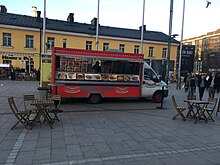
Belgium
Chip trucks have long been a staple of the Belgian countryside. The Belgian Food Truck Association is lobbying to legalize food trucks on the street. Brussels was the first European city to propose locations for food trucks at football matches. Belgium also holds the Brussels Food Truck Festival, the largest of its kind in Europe, every year in May.
France
While it is commonly admitted that the first French food trucks ("camions-restaurants" in French even though the word "foodtruck" is used more frequently) appeared in Marseille in the 1960's with trucks selling pizzas, it is proved that it actually appeared for the first time in Paris back in 1924. At the time, Alfred Morain, the "Préfet" (chief of police) of the Seine region decided to develop and spread what they called then "friteries automobiles" (automobile French fries shop, which were then called "Auto-Morain"). This political measure took place in a context of economical crisis following First World War, which led people to lack essential products, including food. Most of the time, these shops sold 185 grams of French fries and fried fish for "1 franc 25" (1,26€ ,1,38$ in 2023). It also was the first time that fish was sold along with fries in France but then again, this took place in a context of promotion of the French fishing business. The arrival of this kind of shops did not go unnoticed: many press articles and political staging took place. In 1925, "Le Petit Inventeur", a newspaper, commented on the success of the "operation" and on the "very interesting prices ", and, in 1926, Mario (Marius) Roustan, who was the State Under-Secretary dedicated to "public works, ports, merchant marine and fishing" (Sous-Secrétaire d’Etat aux travaux publics, chargé des ports, de la marine marchande et des pêches,), publicised his visit of a "rolling French fries shop" (friterie roulante), which was called "Friterie Auguste" and sold fries and fried fish in Paris.
Nowadays, foodtrucks are very popular in France. Their owners need to obtain permission from four separate government agencies, including the Prefecture of Police. Most of the trucks offer tacos, hamburgers, pizza. Certain regions have specific specialities, such as galette-saucisse (sausage within a buckwheat crepe) in Brittany or fries in the north.
Ireland
Compared to other countries, food trucks in Ireland are a relatively new addition to the Irish food industry. All food trucks in Ireland must be registered with the Health Service Executive (HSE) and are inspected by Environmental Health Officers (EHO).
United Kingdom
With the advent of motorised transport during World War II, food trucks came into common use. Mobile canteens were used in almost all theatres of war to boost morale and provide food as a result of the successful tea lady experiment.
Food trucks today are sometimes known as snack vans or burger vans. They can be found on many major trunk roads at the side of the road or in areas that have a large pedestrian population, such as town centres and events such as village fêtes. These vans can specialise in many different food types, such as doughnuts, hamburgers, chili and chips, as well as ethnic food. Some people prefer to stop at snack vans when travelling, due to the low price, rather than stopping at a motorway service station where prices can be extremely high.
With the British street food industry growing 20% year-on-year, the increase in popularity of having a mobile food van at events has been substantial.
-
 A snack van at the British Museum in London
A snack van at the British Museum in London
-
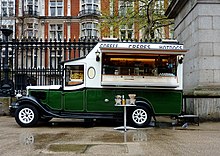 A food truck in London that sells hot dogs, crêpes, and coffee
A food truck in London that sells hot dogs, crêpes, and coffee
-
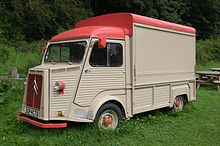 A Citroën HY food van in Norfolk 2016
A Citroën HY food van in Norfolk 2016
-
 A food truck in Hong Kong
A food truck in Hong Kong
-
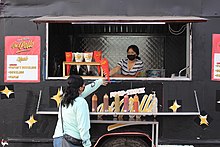 Foodtruck vendor in Monterrey, Mexico
Foodtruck vendor in Monterrey, Mexico
In popular culture
- Both The Great Food Truck Race (Food Network) and Eat St. (Cooking Channel) feature food trucks and mobile food carts from all over the U.S.
- On Food Network Canada, Food Truck Face Off has four teams battle for the grand prize, use of a customized food truck for one year. Also on the network, an episode of Kid in a Candy Store looks behind the scenes at a gourmet dessert truck.
- In the 2014 American comedy-drama film Chef, a high-end chef has a kitchen meltdown and rediscovers his passion for cooking while driving and operating a simple food truck across America.
- During Donald Trump's 2016 campaign for president, Marco Gutierrez, founder of a group known as "Latinos for Trump" warned in an MSNBC interview that there would be "taco trucks on every corner" if Mexican immigration to the U.S. continued.
See also
References
- "food truck". Oxford Dictionaries. Archived from the original on July 16, 2013. Retrieved 12 December 2014.
- "Mobile Food Truck". www.saskatoon.ca/business-development/business-licenses. Saskatoon. 26 May 2015. Archived from the original on 12 April 2020. Retrieved 24 August 2019.
- ^ Lempert, Phil (25 October 2010). "Evolution: The Time for Food Trucks Has Arrived!". Supermarket News. Archived from the original on October 28, 2010. Retrieved 21 February 2015.
- De Cássia Vieira Cardoso, Ryzia; Michèle Companion; Stefano Roberto Marras, eds. (2014). Street Food: Culture, Economy, Health and Governance. Routledge. ISBN 9781138023680.
- "Spotlight: School Children, Street Food and Micronutrient Deficiencies in Tanzania". Rome, Italy: Food and Agriculture Organization of the United Nations. February 2007. Archived from the original on 2015-07-15. Retrieved 2008-02-20.
- Thompson, Bill. "American Chuck Wagon Association". Retrieved 2014-10-30.
- In the Driftway. (1928). . Nation, 126(3281), 589-590.
- Sharpe, P. (1996). Camping it up. . Texas Monthly, 24(9), 92.
- Butler, Stephanie (August 8, 2014). "From Chuck Wagons to Pushcarts: The History of the Food Truck". HISTORY.com (A&E Television Networks). Retrieved 13 December 2014.
- Engber, Daniel (May 2, 2014). "Who Made That Food Truck?". The New York Times. Retrieved 13 December 2014.
- "Eating Clean: How Food Trucks Keep You Safe And Healthy". The Foody Gram. 10 April 2021. Retrieved 2021-04-16.
- "1957". Redstone.army.mil. Archived from the original on January 14, 2010. Retrieved 2010-01-25.
- ^ Urstadt, Bryant (23 September 2009). "Intentionally Temporary". New York Magazine. Retrieved 18 February 2015.
- "Study identifies factors that contribute to food trucks' fast spread". Michigan News. 16 August 2014. Retrieved 26 February 2015.
- ^ Buck, Stephanie (2011-08-04). "The Rise of the Social Food Truck [Infographic]". Mashable.com. Retrieved 2014-10-31.
- Ryssdal, Kai, Food Truck Nation Archived 2012-07-11 at archive.today, American Public Media, Friday, July 30, 2010. Retrieved: September 3, 2011.
- Belluz, J. (2010). Construction guys never ate like this. Maclean's, 123(38), 89.
- ^ Hundley, Wendy (24 March 2015). "Food truck park opening in Plano as suburbs get rolling to catch up with trend". Dallas Morning News. Retrieved 1 July 2015.
- Greene, Cleo (22 December 2014). "Food on the go". WBOC/Fox21. Archived from the original on 17 July 2015. Retrieved 1 July 2015. Published Dec. 2014 ()
- Cicero, Karen (8 April 2013). "Are food trucks safe?". CNN. Retrieved 1 July 2015.
- Reddy, Sumathi (14 Jun 2011). "Every Bride Expects a Lovely Food Truck". Wall Street Journal. Retrieved 20 January 2016.
- Olivia Barker. (n.d). A foodie-fueled trend takes its act on the road. USA Today.
- ^ "Gourmet Meals On Wheels". The Foody Gram. 6 April 2021. Retrieved 2021-04-06.
- "Food Informants: A Week In The Life Of Off The Grid Founder And Owner Matt Cohen". Huffington Post. 2012-08-09. Retrieved 2014-10-31.
- Samuelsson, Marcus, , Mobile Food News.com, June 28, 2011. Retrieved: September 6, 2011.
- "World's largest food truck rally descends on Tampa". Bay News 9. 2013-08-31. Retrieved 2013-09-16.
- The Guinness World record for a food truck rally is still held by Tampa were 121 food trucks gathered in March 2014.
- Eadens, Savannah. "Get ready, Chicago foodies: Chicago Food Truck Festival will host new, unique flavors on wheels". chicagotribune.com. Retrieved 2018-06-26.
- Matchar, Emily (14 May 2015). "How Food Truck Parks Are Making America More Like Southeast Asia". Smithsonian.com (Smithsonian Magazine). Retrieved 1 July 2015.
- Bowling, Danielle (23 August 2012). "The business of street food". Hospitality Magazine. Retrieved 13 December 2014.
- Bellow, Lily; Pou, Jackeline (October 15, 2010). "Starting your own food truck". PBS. Retrieved 21 February 2015.
- "Food Truck FAQs". Toronto Food Trucks (Freshdaily Inc.). Retrieved 13 December 2014.
- Needleman, Sarah E. (9 Aug 2012). "Street Fight: Food Trucks vs. Restaurants". Wall Street Journal. Retrieved 21 February 2015.
- Shannon, Lauren (3 Jun 2013). "Great eats on the go". JapanToday. Retrieved 13 December 2014.
- Gowins, Hilary (26 July 2014). "Three Cities Show How Food Trucks Live and Die on Political Whim". Huffington Post. Retrieved 14 December 2014.
- Eng, Monica (January 31, 2013). "First Chicago food truck gets onboard cooking license". Chicago Tribune. Retrieved 22 February 2015.
- Heagney, Meredith (April 26, 2012). "Food Trucks and Freedom: Law School Hosts Symposium on Mobile Food Laws in Chicago". University of Chicago Law School. Retrieved 22 February 2015.
- Linnekin, Baylen (July 28, 2012). "Chicago's Disgusting New Food Truck Regulations". Reason Magazine. Retrieved 22 February 2015.
- Fasman, J. (2010). Trucking delicious. . Economist, 41-41.
- Matt's Catch Inc. (2022) . . Matt's Catch, 5.
- "2015 Food Truck Industry Statistics Show Worth Of 1.2B". Mobile Cuisine | Food Truck, Pop Up & Street Food Coverage. 16 September 2015. Retrieved 2015-10-07.
- "The best and worst cities for running a food truck". PBS. 21 March 2018.
- Peterson-Withorn, Chase (2014-09-07). "Dessert Startup Founder Looks To Architecture For Inspiration". Forbes. Retrieved 2014-10-30.
- "About Coolhaus". Coolhaus official site. n.d. Archived from the original on 2014-10-13. Retrieved 2014-10-30.
- Linnekin, Baylen (3 March 2018). "Food Trucks Still Under Attack from Regulators". reason.com. Reason. Retrieved 3 August 2019.
- "Street food cards and trucks have grown in stature". Metro. 2012-03-18. Archived from the original on 2013-10-29. Retrieved 2013-10-24.
- Caldwell, A. (2011). Will tweet for food. The impact of twitter and New York City food trucks, online, offline, and inline. Appetite, 56(2), 522-522.
- ^ Woolhouse, Megan; Rocheleau, Matt (2017-06-05). "A major issue for some Boston food trucks? Hand-washing". The Boston Globe. Retrieved 2017-06-05.
- Knowles, Jason; Pistone, Ann (2016-12-15). "Food truck health reports: Lack of surprise inspections". WLS-TV. Retrieved 2017-06-05.
- "Asociación Mexicana de Food Trucks". Time Out México. 2013-09-03.
- Grey, Tim (21 January 2014). "Meals on wheels: Australia's best food trucks". The New Daily. Retrieved 19 February 2015.
- "Food trucks back in business with 'Where The Truck' App | Australian Food News". 2020-05-12. Retrieved 2022-04-25.
- "Finally, food trucks hit the streets in Hong Kong". CNN. 13 February 2017.
- "Les Food Trucks ont désormais leurs emplacements officiels, à Bruxelles". RTBF Info (in French). 8 September 2014. Retrieved 4 November 2016.
- "Le Brussels Food Truck festival attend 70 000 gourmands" (in French). RTBF. 27 Apr 2015. Retrieved 20 January 2016. Original French: "le plus grand festival du genre en Europe"; Google translation: "the largest festival of its kind in Europe"
- "La grande semaine du poisson et la consommation du poisson". L’Indépendant du Berry. September 15, 2023.
- "A Paris le poisson se promène en automobile". Le Petit Inventeur. March 10, 1925.
- "M.Mario Roustan a visité la friterie roulante". Le Nouveau Siècle. March 24, 1926.
- "Les bienfaits de la Friterie Auguste". La Presse. August 20, 1926.
- Moskin, Julia (2012-06-04). "Food Trucks in Paris? U.S. Cuisine Finds Open Minds, and Mouths". The New York Times. pp. A1. Retrieved June 4, 2012.
- "Your Mobile Canteen in Action". Imperial War Museum. Archived from the original on 2011-10-05. Retrieved 2010-07-25.
- "Snack vans: food on the go – in pictures". The Guardian. 26 September 2013. Retrieved 12 December 2014.
- "Post". NCS. Retrieved 2019-10-18.
- Gold, Jonathan (March 2012). "How America Became a Food Truck Nation". Smithsonian Magazine. Los Angeles, CA. Retrieved 2014-10-31.
- Coulton, A., Hamm, L., Zuckerman, S., Alexander, R., Garcia, J., McNeil, L., ... Vallancourt, J. (2010). Food Truck Nation. . People, 74(5), 79-79.
- Weber, David (2012-04-13). "Startup Lessons from the Food Truck Revolution". Fast Company. Retrieved 2014-10-31.
- "The Great Food Truck Race, hosted by Tyler Florence". Foodnetwork.com. 2013-06-27. Retrieved 2013-09-16.
- "Eat Street : Cooking Channel". Cookingchanneltv.com. 2011-02-24. Archived from the original on 2013-01-16. Retrieved 2013-09-16.
- "Food Truck Face Off". Food Network (Shaw Media). Retrieved 12 December 2014.
- Gertler, Adam. "Blissfully Sweet (KR0106)". Kid in a Candy Store. Season 1. Episode 6. Food Network. Archived from the original on 2021-12-12. Available on YouTube. Retrieved 2014-10-27.
- "Latinos for Trump Founder: 'Defend Your Country' from Hispanics". nbcnews.com. 2016-09-02. Retrieved 2016-09-04.
External links
 Media related to Food trucks at Wikimedia Commons
Media related to Food trucks at Wikimedia Commons- Food Truck Nation, report on regulations in the U.S.
- Food Truck Directory, by MOBLZ
| Meals | |
|---|---|
| Common meals | |
| Components and courses | |
| Table service | |
| Presentation | |
| Dining | |
| Regional styles | |
| Packed | |
| Menus and meal deals | |
| Communal meals | |
| Catering and food delivery | |
| Places to eat | |
| Related | |
